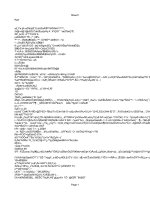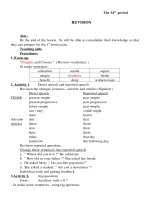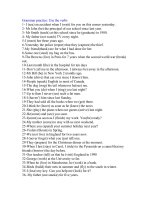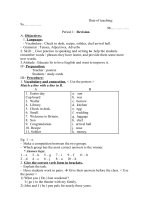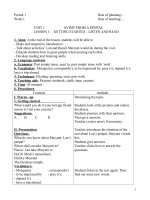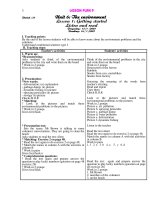Giáo án Tiếng Anh 9 HKII
Bạn đang xem bản rút gọn của tài liệu. Xem và tải ngay bản đầy đủ của tài liệu tại đây (216.12 KB, 34 trang )
Lesson plan 9
Period : 37 Unit 6: The environment
Lesson 1: Getting started
Listen and read
Preparing: 14 /1 /2007
Teaching: 16 / 1 /2007
I. Teaching points:
By the end of the lesson students will be able to know more about the environment problems and the
solutions
Understand conditional sentence type I
II. Teaching steps:
Teacher's activities Students' activities
1. Warm up:
*Brainstorming:
Asks students to think of the environmental
problems in the city and write them on the board
? Work in 2 groups
Gives feed back
2. Presentation:
*New words:
- deforestation: (n) explanation
- garbage dump: (n) picture
- dynamite fishing (n) picture
- spraying pesticides (n) picture
- sewage (n) picture
Checks R.O.R
* Matching:
? Look at the pictures and match these
environmental problems to the pictures
? Work in 2 groups
Gives feed back
* Presentation text:
Sets the scene: Mr Brown is talking to some
volunteer conversations. They are going to clean the
beach
Asks students to read the text silent
* Matching: Exercise 2 on page 48.
? Read the text again to do exercise 2 on page 48.
Think of the environmental problems in the city
and write them on the board
Work in 2 groups
Destruction of the forests
Rubbish
Smoke from cars, motorbikes
Smoke from factory
Guessing the meaning of the words from
teacher's eliciting
Read and repeat
Copy them
Check R.O.R
Look at the pictures and match these
environmental problems to the pictures
Work in 2 groups
Picture a. air pollution
Picture b. spraying pesticides
Picture c. garbage dump
Picture d. water pollution
Picture e. deforestation
Picture f. dynamite fishing
Listen to the teacher
Read the text silent
Read the text again to do exercise 2 on page 48.
Match the names in column A with the activities
in column B
Work in pairs
1. f 2. e 3. b 4. a 5. c 6. d
1
Lesson plan 9
? Match the names in column A with the activities in
column B
? Work in pairs
Gives feed back n
* Comprehension questions:
? Read the text again and prepare answer the
question to play lucky numbers (question on page 48
exercise 2b)
? Work in 2 groups
Gives feed back
* Model sentences:
Elicits: If you can't find your place I will help you
get there with this map
? Give form
? How can you use it?
3 Practice
* Matching: exerciser 4 on page 56 in language
focus
Runs through the sentences in exercise 4
? Match column A with column B
? Work in pairs
Gives feed back
4. Production:
* Write it up:
? Work in 2 groups
? One group makes a half sentence with form: " If +
S +V present tense " other makes a half sentence
with form: S + V future tense"
? One student in your group read a half sentence
other read their half sentence.
Gives feed back
5. Home work:
? Do exercise in exercise books
Read the text again and prepare answer the
question to play lucky numbers (question on page
48 exercise 2b)
Work in 2 groups
1. Mr Brown
2. members of the volunteer
3. on the beach
4. clean the beach
5. If they work hard today, they will make the
beach clean and beautiful again soon.
6. Yes, I have.
7. The environment around us won't be good and
it will be harmful to our health, our life.
Listen and look at the Model sentences
Form: If + S +V present tense, S + V future tense
Use: Express persuasion
Look at the sentences
Match column A with column B
Work in pairs
1. e 2. a 3. c 4. d 5. b
Work in 2 groups
One group makes a half sentence with form: " If
+ S +V present tense " other makes a half
sentence with form: S + V future tense"
One student in their group read a half sentence
other read their a half sentence
Do exercise in exercise books
Display on the board
1. New words:
- deforestation: (n) Sù tµn ph¸ rõng
- garbage dump: (n) ®èng r¸c
2
Lesson plan 9
- dynamite fishing (viec ®¸nh b¾t c¸
- spraying pesticides (n) viÖc phun thuèc s©u bä
- sewage (n) picture nuíc cèng
2. Matching:
3. Presentation text:
4. Model sentences:
Elicits: If you can't find your place I will help you get there with this map
5. Matching: exercise 2 on page 48.
6. Comprehension questions
7. Model sentences: If you can't find your place I will help you get there with this map
Form: If + S +V present tense, S + V future tense
Use: Express persuasion
8. Matching: exerciser 4 on page 56 in language focus
9. Write it up:
10. Home work:
Period: 38 Unit 6: Lesson 2: Speaking
Preparing: 17/1 /2007
Teaching: 19 / 1 /2007
I. Teaching points:
By the end of the lesson students will be able to persuade other people by using given expression: I
think you should...; Why not... ? Why don’t you?
II. Teaching steps:
Teacher's activities Students' activities
1. Warm up: * Jumble words
- onpilulo
- mpud
- ira
- sptesesecidi
- ands
? Work in 2 groups
? Write the right words
Gives feed back
2. Pre speaking–
*New words
- Wraps (v) (mine)
- Reduce: (v) ( Example)
- faucet: (n) (picture)
- Leaf – leaves : (realia)
Checks R.O.R
*Matching:
? Read the words in column A and B then match
? Work individually
Gives feed back
Notes:
Work in 2 groups
Write the right words
pollution
dump
air
pesticide
sand
Guessing the meaning of the words from
teacher's eliciting
Read and repeat
Copy them
Check R.O.R
Read the words in column A and B then match
Write note
3
Lesson plan 9
I think you should
Won’t you
It would be better if you
can I persuade you to Why don’t you
Why not
Express persuasion
3. While speaking
*Work in pair
? Persuade your partners to do things to protect the
environment.
Calls some pairs to practice in the front of the class
3. Post speaking:
*Survey:
? Work in groups
? Ask your friends and fill in the table using the
questions:
How can we...
- save paper?
- use fewer plastic bags?
- reduce water pollution?
- prevent littering?
- reduce air pollution?
Nam
e
How can do...
Gives feed back
4. Home work:
Do exercises in exercises books, prepare lesson 3
Persuade their partners to do things to protect the
environment
Some pairs to practice in the front of the class
A: I think it would be better if we reuse and
recycle bottles and cans
B: Why? How come?
A: Because reusing and recycling bottlers
...
Work in groups
Ask their friends and fill in the table using the
questions
Do the tasks
Do exercises in exercises books, prepare lesson 3
Display on the board
1. New words:
- Wraps (v) gãi
- Reduce: (v) gi¶m
- faucet: (n) vßi níc
- Leaf – leaves: (n) l¸ c©y
2. Reading:
*Matching:
I think you should
Won’t you
It would be better if you
Can I persuade you to why don’t you?
4
Lesson plan 9
Why not
Express persuasion
*Survey:
How can we...
- save paper?
- use fewer plastic bags?
- reduce water pollution?
- prevent littering?
- reduce air pollution?
Nam
e
How can do...
3. Home work:
Period : 39 Unit 6: Lesson 3: Listen
Preparing: 14 /1 /2007
Teaching: 16 / 1 /2007
I. Teaching points:
By the end of the lesson students will be able to improve vocabulary and knowledge about
environment.
II. Teaching steps:
Teacher's activities Students' activities
1. Warm up:
* Sentences race:
Gives new words:
banana leaves
plastic bags
garbage
...
Asks students to make the sentences with the words
teacher say
? Work in 2 groups
? Write your sentences on the board
Gives feed back
2. Pre listening
* New words:
- Raw sewage (n)
- marine life (n)
- Waste materials (n)
- Regulation (n)
Checks R.O.R
Sets the scene: You are going to listen to a report on
how our oceans are polluted
Gives poster and asks students to read the words
carefully
Make the sentences with the words teacher say
Work in 2 groups
Write their sentences on the board
Guessing the meaning of the words from
teacher's eliciting
Read and repeat
Copy them
Check R.O.R
Listen
Look at the poster and read the words carefully
Guess information to fill in the bland
5
Lesson plan 9
? Guess information to fill in the bland
? Work in groups
3. While listening:
Asks students to listen to the tape to check the guess
* Questions given:
1. How are our oceans becoming extremely
polluted?
2. Where does most of this pollution come from?
3. Where do waste materials come from?
4. What will happen if a ship has an accident?
? Listen to the tape again to answer the questions ?
? Work in 2 groups
Gives feed back
4. Post listening:
* Retell:
? Use the words in poster and the answer to retell
the content of the listening
Calls some students to do the tasks
Gives feed back
5. Home work
? Do exercises in exercises books, prepare lesson 4
Work in groups
Listen to the tape to check the guess
1. garbage is
2. come from ships at sea
3. Waste materials come from factories.
4. Oil is washed from the land.
Listen to the tape again to answer the questions
Work in 2 groups
1. extremely polluted
2. the land
3. factories
4. oil will spills from the vessel
Use the words in poster and the answer to retell
the content of the listening
Do the tasks
Do exercises in exercises books, prepare lesson 4
Display on the board
1. New words:
- Raw sewage (n)
- marine life (n)
- Waste materials (n)
- Regulation (n)
2. Listening:
1. garbage is
2. come from ships at sea
3. Waste materials come from factories.
4. Oil is washed from the land.
* Questions given:
1. extremely polluted
2. the land
3. factories
4. oil will spills from the vessel
* Retell:
3. Home work
6
Lesson plan 9
Period: 40 Unit 6: Lesson 4: Read
Preparing: 28 /1 /2007
Teaching: 30 / 1 /2007
I. Teaching points:
By the end of the lesson students will be able to understand the poem about the environment
II. Teaching steps:
Teacher's activities Students' activities
1. Warm up:
*Kim game:’
Gives the picture and asks students to look at the
picture carefully to remember the things in the
picture
? Write the things on the board
? Work in 2 groups
Gives feed back
2. Pre reading
* New words;
- Treasures: (n) ( translation)
- stream: (n) (picture)
- foam: (n) (picture)
- hedge: (n) (picture)
- Junk yard: (n) (synonym)
Check: R.O.R
*Gap fill
Gives table:
If all the pollution goes on what will happen?
1. The world ..................................
2. The treasures.........................................
3. The stream.......................................
4. The fields.......................................
5. The woods..........................................
Asks students to read the words in the table carefully
and guess information in the bland
? Work in groups
3. While reading:
Asks students to reading the poem to check the
guess
Gives feed back
Look at the picture carefully to remember the
things in the picture
Write the things on the board
Guessing the meaning of the words from
teacher's eliciting
Read and repeat
Copy them
Check R.O.R
Read the words in the table carefully and guess
information in the bland
Reading the poem to check the guess
If all the pollution goes on, what will
happen?
1 The world will end up like a second -
hand junk - yard
2 The treasures will be destroyed (quite
gone)
3 The wood will be polluted
4 The streams will be covered with foam
7
Lesson plan 9
*Matching:
Asks students to read the poem again to match the
word in A to an appropriate explanation in B
? Work in individually
Gives feed back
b
Asks students to read the questions and the poem to
prepare the answers
? Work in 2 groups to play the game Lucky numbers
Gives feed back
4. Poster reading
* Survey:
Gives table:
What could you do in your school/ house to
minimize pollution?
Name What do....
? Work in groups
? Ask your friends and fill in the table using the
question:
Gives feed back
5. Home work
Do exercises in exercises books, prepare lesson 4
5 The fields will be littered with plastics
and tins
Read the poem again to match the word in A to
an appropriate explanation in B
1. c 2. g 3. f 4. e 5. d 6. a 7. b
Read the questions and the poem to prepare the
answers
Play the game Lucky numbers
Do the tasks
Ask their friends and fill in the table using the
question:
Do exercises in exercises books, prepare lesson 4
Display on the board
1. New words:
- Treasures: (n) vËt quý b¸u
- stream: (n) suèi
- foam: (n) bät
- hedge: (n) hµng rµo
- Junk yard: (n) r¸c th¶i
2. Reading:
*Guessing missing the information:
If all the pollution goes on what will happen?
1. The world ..................................
2. The treasures.........................................
3. The stream.......................................
4. The fields.......................................
5. The woods..........................................
*Matching:
1. c 2. g 3. f 4. e 5. d 6. a 7. b
*Questions given:
8
Lesson plan 9
* Survey:
What could you do in your school/ house to
minimize pollution?
Name What do....
Period: 41 Unit 6: Lesson 5: Write
Preparing: 29/1 /2007
Teaching: 31 / 2 /2007
I. Teaching points:
By the end of the lesson students will be able to write a complaint letter
II. Teaching steps:
Teacher's activities Students' activities
1. warm up
*Categories
Asks students to find out the verbs beginning with
the letters that teacher give
a. b. c. d e. f. g. h. j
? Work in 2 groups
Gives feed back
2. Pre writing
* Pre teach: New words
- complain (v)
- Resolution (n)
- Float (v)
- Prohibit (v)
Checks R.O.R
* Ordering
a. Action: talks about future action
b. Situation: states the reason for writing
c. politeness: ends the letter politely
d. Complication: mention the problem
e. Resolution: Make a suggestion
? Work in pair to put the sections in a correct order
Gives answer keys
1.b 2. d 3. e 4. a 5. c
* Matching
? Read the letter to match
? Work in pairs
Gives feed back
3. While writing
Find out the verbs beginning with the letters
Work in 2 groups
Guessing the meaning of the words from
teacher's eliciting
Read and repeat
Copy them
Check R.O.R
Work in pair to put the sections in a correct order
Read the letter to match
9
Lesson plan 9
* Questions given
a. What do people do in the lake behind your house
these days?
b. What makes you worried?
c. To whom do you write the letter to ?
d. What suggestion do you want to make?
? Read the letter again to answer the questions
? Work in pairs
Gives feed back
* Write it up
? Write letter individually and then share with your
friends.
4. Post reading
* Correction
Take some letters to correct on front of the class
5. Home work
? Do exercise in to note book
Read the letter again to answer the questions
Work in pairs
Write letter individually and then share with their
friends.
Correct letters
Do exercise in to note book
Display on the board
1. New words:
- complain (v)
- Resolution (n)
- Float (v)
- Prohibit (v)
2. Writing
* Ordering
a. Action: talks about future action
b. Situation: states the reason for writing
c. politeness: ends the letter politely
d. Complication: mention the problem
e. Resolution: Make a suggestion
* Matching
* Questions given
* Write it up
* Correction
3. Home work
Period: 42 Unit 6: Lesson 6: Language focus
Preparing: 4 /2 /2007
Teaching: 6 / 2 /2007
I. Teaching points:
By the end of the lesson students will be able to use adj and advers to make sentences with adj + that
clause
II. Teaching steps:
Teacher's activities Students' activities
1. Warm up
*Pelmanism Choose the number
10
Lesson plan 9
Gives 12 cards which have adj and adverbs
? Work in 2 groups
Gives feed back
2. Presentation
*Pre teach : New words
- sigh (v)
- amazed (a)
- disappointed (a)
Checks : what and where
3. Activity 1: Revision of adj and adverbs
Asks students to give form
Adj + ly = Adverb of manner
Asks students to use the adverbs provided in
“Pelmanism game” to complete
Gives feed back
4. Activities 2
Sets the scene to introduce the structure
adj + that clause
Ba: Dad! I got mark 9 on my test
Father: That/s wonderful. I’m please that you are
working hard
Asks students to give form
Asks students to do exercise 3 P55
5. Home work
? Do exercise 2 in your note book
Work in 2 groups
extreme extremely happy happily sad sadly good
well slowly fast fast
Guessing the meaning of the words from
teacher's eliciting
Read and repeat
Copy them
Check what and where
Give form
Adj + ly = Adverb of manner
Use the adverbs provided in “Pelmanism game”
to complete
Listen and think about them
Give form
S + be + adj + that clause
Do exercise 3 P55
Do exercise 2 in your note book
Display on the board
1. New words:
- sigh (v)
- amazed (a)
- disappointed (a)
2. Revision of adj and adverbs
Adj + ly = Adverb of manner
3. Activities 2
Form
S + be + adj + that clause
4. Home work
Period: 43 Unit 7: Saving energy
Lesson 1: Getting started
Listen and read
Preparing: 5 /2 /2007
Teaching: 7 / 2 /2007
11
Lesson plan 9
I. Teaching points:
By the end of the lesson students will be able to understand the dialogue and about the ways to save
energy
II. Teaching steps:
Teacher's activities Students' activities
1. Warm up
*Chatting:
Asks students to look at the picture P 57 to answer
some questions
? Who is watching T.V?
? Is light still burning?
? What happens to faucets ?
? Should we turn the T.V off?
2. Pre reading
*Pre teach: New words
- Water bill (n)
- Enormous (adj)
- Reduce (v)
- Plumber (n)
- Crack (n)
- dripping faucets (n)
Checks: R.O.R
* T/F statements Prediction
Sets the scene: Mrs ha is talking to his neighbor,
Mrs Ha and Mr ha looks very worried
? Work in pairs
? Read T or F statement carefully
? Guess F or T
3. While reading
Asks students to read the dialogue to check T or F
? If it is F why? and how can you correct?
*Comprehension questions
? Read the dialogue again
? Work in pairs to find out the answer the questions
Asks students to play the game: Lucky numbers
4. Post reading
* Discussion
? Work in 2 groups
? Discuss the topic: “What do you do to save
energy at home and at school?”
? Calls some leader of the groups to talk in the front
of the class
5. Home work
? Do exercise in to note books
Look at the picture P 57 to answer some
questions
Guessing the meaning of the words from
teacher's eliciting
Read and repeat
Copy them
Check R.O.R
Listen
Read T or F statement carefully
Guess F or T
Read the dialogue to check T or F
Read the dialogue again
Work in pairs to find out the answer the questions
Discuss the topic: “What do you do to save
energy at home and at school?”
Leader of the groups to talk in the front of the
class
Do exercise in to note books
12
Lesson plan 9
Display on the board
1. New words:
- Water bill (n)
- Enormous (adj)
- Reduce (v)
- Plumber (n)
- Crack (n)
- dripping faucets (n)
2. Reading
* T/F statements Prediction
*Comprehension questions
* Discussion
3. Home work
Period: 44 Unit 7: Saving energy
Lesson 2: Speak
Preparing: 21 /2 /2007
Teaching: 23 / 2 /2007
I. Teaching points:
By the end of the lesson students will be able to make and respond to suggestions
II. Teaching steps:
Teacher's activities Students' activities
1. Warm up
*Kim game
Asks students to look at the picture on P 59 to
remember the things in 20 seconds
? Work in 2 groups
Gives feed back
2. Pre speaking
Elicits from students to draw the exchange
I suggest taking a shower
Ok. I’ll do that
Asks students to find out other ways of making
suggestions
3. While speaking
* Pictures drill
Asks students to do Exercise 3 a on P 58-59
Asks students to look at the pictures on P 59 and
table on P 58 and make responses to the
suggestions
* Write it up
? Look at the pictures to make suggestions about
how to save energy at home
? Work in pairs to write down
Look at the picture on P 59 to remember the
things in 20 seconds
Work in 2 groups
Find out other ways of making suggestions
Look at the pictures to make suggestions about
how to save energy at home
Work in pairs to write down
13
